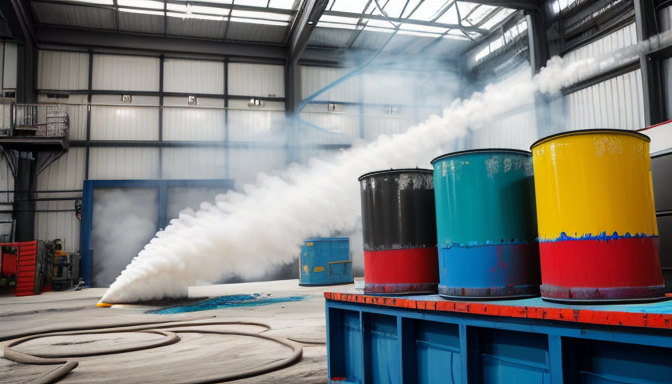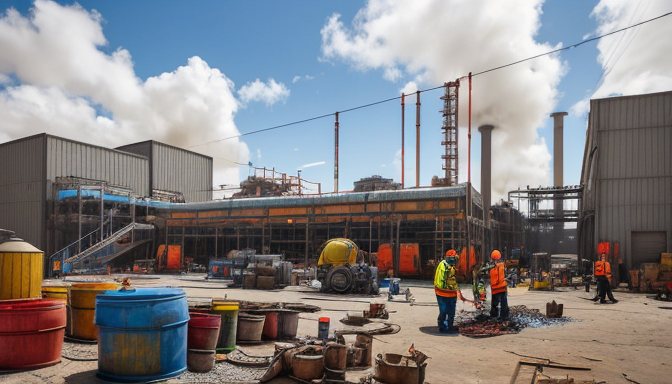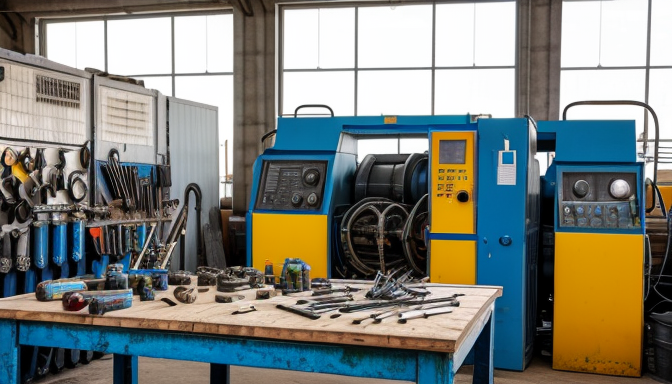When it comes to prepping surfaces for a fresh coat of paint or protective layer, sandblasting and painting are two processes that go hand in hand. They might seem simple, but there’s a lot more beneath the surface. Imagine trying to paint a wall without cleaning it first. It just wouldn’t stick, right? That’s where sandblasting comes in. It’s like a deep clean for surfaces, removing old paint, rust, and grime, making everything ready for a new look.
Now, let’s dive into what these processes entail. Sandblasting, also known as abrasive blasting, uses high-pressure air to shoot tiny particles, like sand or glass beads, at a surface. This technique not only cleans but also prepares the surface for painting. Think of it as giving your surface a rough texture, which helps the new paint adhere better. Without this step, your paint job might peel or chip away, leading to more work down the line.
Once the surface is prepped, it’s time for painting. This is where the fun begins! You can choose from a variety of paints, each with its own unique properties. Some are designed for durability, while others are all about aesthetics. Choosing the right paint is crucial. It’s like picking the right outfit for an occasion. You want something that looks good but also lasts. So, consider the environment the painted surface will face. Is it indoors or outdoors? Will it face harsh weather? These factors will influence your choice.
Many people wonder about the costs involved in sandblasting and painting. It’s essential to understand that several factors can influence pricing. The size of the project, the materials used, and the complexity of the job all come into play. Generally, larger surfaces will cost more, but they might also save you money in the long run due to fewer maintenance needs. Here’s a quick breakdown:
| Factor | Impact on Cost |
|---|---|
| Surface Size | Larger areas increase costs |
| Material Type | Different materials have varying prices |
| Job Complexity | Intricate designs may cost more |
But it’s not just about costs. The weight of the materials used in sandblasting and painting can impact structures significantly. For instance, if you’re working on a bridge, the weight of the coatings must be considered. A heavy coating can stress the structure, while a lighter option might be ideal. This is especially true in engineering applications where every ounce counts.
In conclusion, sandblasting and painting are essential processes that enhance both the durability and appearance of surfaces. Whether you’re a DIY enthusiast or a professional, understanding these techniques can save you time and money. So, before you grab that paintbrush, think about the prep work. After all, a solid foundation leads to a flawless finish!
Sandblasting and Painting Cost
Understanding the costs associated with sandblasting and painting is crucial for anyone considering these services. You might be wondering, “What makes up the total cost?” Well, there are several factors at play. First, the size of the project plays a significant role. Larger surfaces require more materials and labor, naturally increasing the cost.
Next, consider the type of materials used. High-quality paints and abrasives can be more expensive, but they often provide better durability and finish. So, while you might spend a bit more upfront, you could save money in the long run by avoiding frequent touch-ups.
Labor costs also vary. If you’re hiring professionals, their experience and expertise can impact the price. A seasoned crew might charge more, but they can deliver superior results. On the other hand, if you’re thinking of doing it yourself, you can save on labor but may face the challenge of learning the ropes. Remember, the learning curve can be steep!
To give you a clearer picture, here’s a simple breakdown of potential costs:
| Item | Estimated Cost |
|---|---|
| Sandblasting (per square foot) | $1 – $3 |
| Painting (per square foot) | $2 – $6 |
| Materials (paints, abrasives) | $100 – $500 |
| Labor (per hour) | $50 – $100 |
In addition to these costs, don’t forget about preparation and cleanup. These steps are essential to ensure a smooth finish and can add to your budget. For example, if the surface needs extensive cleaning or repair before the actual sandblasting and painting, those costs will accumulate.
So, how do you budget for your project? Start by getting quotes from several contractors. Compare their prices and services. Look for reviews or ask for references. This way, you can ensure you’re getting the best value for your investment.
In conclusion, while the costs of sandblasting and painting can vary widely, understanding the factors involved will help you make an informed decision. Whether you’re sprucing up your home or tackling a commercial project, knowing what to expect can save you time and money.

Sandblasting and Painting Weight Impact
The weight of coatings applied through sandblasting and painting can have a significant influence on the overall performance and integrity of structures. Think about it: when you add a layer of paint or a protective coating, you’re not just changing the color. You’re altering the dynamics of the material underneath. This is especially crucial in construction and manufacturing, where every ounce counts.
For example, when sandblasting prepares a surface, it removes old paint and rust, making way for a new layer. But this new layer, whether it’s a thick coat of paint or a protective sealant, adds weight. This added weight can affect structural elements like beams and supports. If you’re not careful, you might end up with a design that can’t handle the extra load.
Consider these factors when evaluating the weight impact:
- Type of Coating: Different materials have different densities. A heavy epoxy might be great for protection but can add significant weight.
- Application Thickness: The thicker the application, the more weight is added. It’s a balancing act between protection and structural integrity.
- Surface Preparation: Proper sandblasting can minimize the need for excessive layers, helping to keep weight down.
Now, let’s break it down further. Here’s a simple table that illustrates the weight differences between common coatings:
| Coating Type | Weight per Square Foot (lbs) |
|---|---|
| Latex Paint | 0.5 |
| Oil-Based Paint | 0.7 |
| Epoxy Coating | 1.0 |
| Polyurethane Coating | 0.8 |
This table shows that while latex paint is light, epoxy coatings can add a noticeable amount of weight. When planning a project, it’s essential to consider these numbers. You don’t want to overload your structure unknowingly.
Additionally, the weight impact isn’t just about the materials; it’s about how they interact with the environment. For instance, in areas with heavy winds or seismic activity, the added weight from coatings can change how a building or structure behaves. It’s like wearing a heavy backpack while trying to run. You have to adjust your movements!
In conclusion, understanding the weight impact of sandblasting and painting isn’t just a technical detail; it’s a crucial aspect of any project. By carefully selecting materials and methods, you can ensure that your structure remains safe and functional while still looking great.
Sandblasting and Painting Techniques
When it comes to sandblasting and painting, the techniques you choose can make all the difference. Think of it like cooking. You wouldn’t use the same method for every dish, right? Each project has its own unique needs. Let’s dive into some of the most popular techniques and see how they can transform your surfaces.
First up is abrasive blasting, commonly known as sandblasting. This technique involves shooting abrasive materials at high speeds to clean or prepare surfaces. It’s like giving your surface a fresh start! Abrasive blasting can remove rust, paint, and other contaminants, making it an essential step before painting. There are different types of abrasives used, such as:
- Sand
- Glass beads
- Aluminum oxide
- Steel grit
Each abrasive has its own characteristics and is suited for different tasks. For instance, glass beads are great for a smooth finish, while steel grit is more aggressive and effective for heavy-duty cleaning.
Next, let’s talk about spray painting. This technique is popular due to its speed and efficiency. It involves using a spray gun to apply paint evenly over a surface. Imagine painting a fence with a brush. Now, picture doing it with a spray can. Which one would be faster? Exactly! Spray painting can cover large areas quickly, but it requires skill to avoid drips and uneven coats.
Another technique worth mentioning is powder coating. This method involves applying a dry powder that is then cured under heat. The result? A durable, high-quality finish that’s resistant to chipping and scratching. It’s like putting on a protective armor for your surfaces! Powder coating is often used for metal items like furniture and automotive parts.
Now, you might be wondering, which technique is best for your project? Well, it depends on various factors, including:
- The type of material you are working with
- The desired finish
- Your budget
- The environmental conditions
For example, if you’re working on a metal surface that needs heavy cleaning, abrasive blasting might be your go-to. But if you’re looking for a sleek, modern finish, powder coating could be the answer.
In conclusion, understanding these techniques can help you make informed decisions for your sandblasting and painting projects. Remember, it’s not just about applying paint; it’s about choosing the right method to achieve the best results. So, the next time you tackle a project, think about the techniques you’ll use. They can truly make or break your outcome!

Sandblasting and Painting Applications
Sandblasting and painting are not just fancy terms thrown around in the construction world. They are essential processes that breathe new life into various materials and structures. Imagine a rusty old car, sitting in a garage, waiting for someone to give it a makeover. That’s where sandblasting comes in! This technique strips away the old, worn-out paint and rust, preparing the surface for a fresh coat of paint. It’s like giving that car a clean slate, ready to shine again.
But the applications of sandblasting and painting go far beyond just cars. These processes are widely used in different industries, each with unique needs and requirements. For instance, in the marine industry, boats and ships often face harsh conditions. Sandblasting removes salt, grime, and old paint, while painting provides a protective layer against corrosion. It’s like putting on a raincoat before stepping out into the storm!
In the construction sector, sandblasting is a favorite for prepping surfaces before painting. Whether it’s steel beams or concrete walls, this technique ensures that the paint adheres properly, enhancing durability. Think of it as giving the surface a good scrub before applying moisturizer. Without that prep, the paint might just peel off like dry skin!
Here are some key industries where sandblasting and painting are commonly applied:
- Aerospace: Aircraft need to be lightweight yet durable. Sandblasting removes old coatings, and specialized paints protect against extreme conditions.
- Manufacturing: Equipment and machinery often undergo sandblasting to remove contaminants, followed by painting to ensure longevity.
- Automotive: From classic cars to modern vehicles, sandblasting and painting help restore and protect vehicles.
- Art and Decor: Artists use sandblasting to create stunning designs on glass and stone, while paint adds color and vibrancy.
Moreover, the aesthetic aspect of painting cannot be overlooked. In the interior design world, a fresh coat of paint can transform a dull room into a vibrant space. It’s like changing the mood of a party just by switching the lights! Sandblasting prepares surfaces for this transformation, ensuring that the paint job lasts.
In conclusion, the applications of sandblasting and painting are vast and varied. They serve not only functional purposes but also enhance the beauty of structures and materials. Whether it’s protecting a boat from the sea or giving a car a new look, these processes play a crucial role in maintaining and improving our world. So, the next time you see a freshly painted surface, remember the hard work that went into preparing it!
Frequently Asked Questions
- What is sandblasting and how does it work?
Sandblasting, also known as abrasive blasting, is a process that propels abrasive materials at high speeds to clean or prepare surfaces. It works by using compressed air to shoot fine particles, like sand, against a surface, removing paint, rust, or other contaminants. Think of it like using a high-powered shower to wash away dirt!
- How much does sandblasting and painting cost?
The cost of sandblasting and painting can vary widely based on factors like the size of the project, the materials used, and the complexity of the job. Generally, you can expect to pay anywhere from $1 to $5 per square foot. It’s always a good idea to get multiple quotes to ensure you’re getting the best deal!
- What are the weight implications of coatings?
The weight of coatings applied through sandblasting and painting can significantly affect structures, especially in construction. Different materials have different weights, and applying a heavy coating can lead to structural issues if not properly accounted for. It’s like putting on a heavy winter coat; it can feel burdensome if it’s not suited for the occasion!
- What techniques are commonly used in sandblasting and painting?
There are several techniques for sandblasting and painting, including dry blasting, wet blasting, and powder coating. Each method has its own advantages, such as reduced dust or enhanced finish quality. Choosing the right technique is crucial for achieving the desired results, much like selecting the right tool for a DIY project!
- What industries utilize sandblasting and painting?
Sandblasting and painting are used in a variety of industries, including automotive, aerospace, construction, and manufacturing. These processes not only enhance the durability of products but also improve their aesthetic appeal. It’s like giving your car a fresh coat of paint—it looks better and lasts longer!
